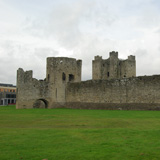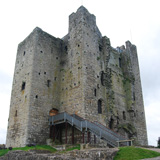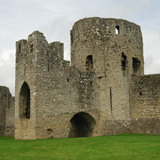History
Trim Castle resides in County Meath in Ireland, along the banks of the River Boyne. It was built during the late 12th century after Henry II granted Hugh de Lacy Lordship of Meath to limit expansion by Richard de Clare, Earl of Pembroke, also known as Strongbow.

Strongbow was an ambitious baron Henry feared would facilitate an independent Anglo-Norman kingdom in Ireland if left unchecked. Upon Hugh de Lacy's arrival in Ireland, he supplemented the castle with a wooden fortress and spiked stockade, as mentioned in the poem "Song of Dermot and the Earl" composed during that period:
Then Hugh de Lacy
Fortified a house at Trim
And dug a ditch around it
And enclosed it within a stockade
Within the house he then placed
Great Knights and Barons
De Lacy departed for France in 1173 and left Trim Castle in the care of a baron named Hugh Tyrell. However, Ruardhi O'Connor, King of Connacht, considered the land his own, attacked Meath, and eventually burned the vacated castle. Upon Tyrell's return in 1176, he rebuilt the structure, beginning with a stone keep. Once constructed, a curtain wall, gate, and moat surrounded it. In 1196, the keep was enlarged by adding two new floors and a Great Hall on the third floor. Eventually, the Great Hall proved too difficult to access for more extensive public gatherings and was ultimately divided into separate rooms.
In 1194, Walter de Lacy attacked lands owned by Prince John when John served in conflict against his brother, King Richard I. Upon reconciliation between the king and prince, Walter was deprived of his lands until he agreed to pay a hefty fine in return for the king's benevolence. Following the death of King Richard I in 1199, John became king and Walter his servant. Walter remained in England while royal officials administered his lands. In 1207, King John and Walter de Lacy reconciled, and Walter returned to Trim Castle. After a brief visit to England in 1223, Walter de Lacy returned and besieged the castle for seven weeks in 1224, reclaiming it from his rebellious brothers, who took control during his absence. Upon Walter de Lacy's death in 1241, the castle passed to his granddaughter, Maud, who married Geoffrey de Geneville in 1254, which began a period of prosperity for Trim Castle. During this time, a new Great Hall was constructed along the north curtain wall, and the north tower was converted into a solar.
In 1306, de Geneville's granddaughter Joanna, married Roger Mortimer, 1st Earl of March. Their descendants retained ownership of the castle for approximately 120 years until the death of Edmund, 5th Earl of March, in 1425. Richard II visited Trim in 1399 and left Prince Hal, later Henry V, as a prisoner in the castle.
During the 15th century, Trim Castle was used to host parliaments on seven occasions. By the 16th century, it existed in an advanced state of decline and was eventually abandoned. In the mid-16th century, during the Cromwellian Wars, the castle was pillaged by soldiers and inhabitants of the town who took roof beams and lead from the dilapidated structure.
In 1993, Trim Castle was purchased by the state from Lord Dunsany. Today, it is managed by Heritage Ireland, the Heritage Service of the Department of the Environment and Local Government.
Castle Highlights
Trim Castle is the largest castle in Ireland and represents a fine example of 12th century Anglo-Norman domination in Ireland. A stunning keep accentuates its architecture in the shape of a Greek cross. In addition, the Trim Gate to the west retains enough of its original structure to convey a sense of the once massive form. Today, it serves as the main entrance to the castle for visitors.
The Barbican Gate and remains of the 13th century curtain walls on the east end of the castle are equally impressive. Both may look familiar as they were used in the 1995 movie Braveheart starring Mel Gibson, who portrayed William Wallace, a late 13th-century Scottish warrior. The keep represented the Tower of London and Edinburgh Castle. At the same time, the Barbican Gate and curtain wall represented the City of York and Wallace's visitation with the Princess of Wales after he crossed the River Boyne via a wooden barge to meet her.
I highly recommend taking a guided tour of the castle and crossing the River Boyne to enjoy awe-inspiring views from a distance. There are bridges at either end of the castle to cross the river.


